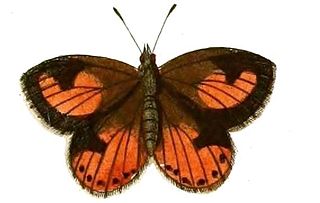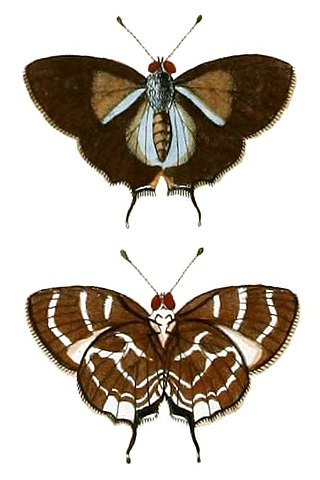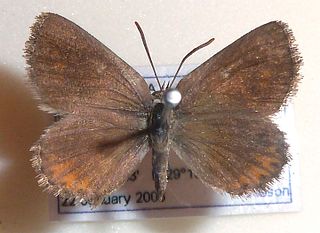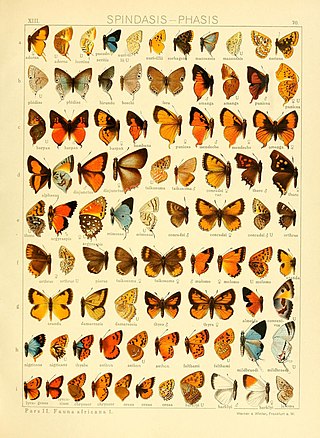
Lycaenidae is the second-largest family of butterflies, with over 6,000 species worldwide, whose members are also called gossamer-winged butterflies. They constitute about 30% of the known butterfly species.

Riodinidae is the family of metalmark butterflies. The common name "metalmarks" refers to the small, metallic-looking spots commonly found on their wings. The 1,532 species are placed in 146 genera. Although mostly Neotropical in distribution, the family is also represented both in the Nearctic, Palearctic, Australasian (Dicallaneura), Afrotropic, and Indomalayan realms.

The Satyrini is one of the tribes of the subfamily Satyrinae. It includes about 2200 species and is therefore the largest tribe in the subfamily which comprises 2500 species.

Miletinae is a subfamily of the family Lycaenidae of butterflies, commonly called harvesters and woolly legs, and virtually unique among butterflies in having predatory larvae. Miletinae are entirely aphytophagous. The ecology of the Miletinae is little understood, but adults and larvae live in association with ants, and most known species feed on Hemiptera, though some, like Liphyra, feed on the ants themselves. The butterflies, ants, and hemipterans, in some cases, seem to have complex symbiotic relationships benefiting all.

Aloeides, commonly called coppers, is a genus of butterflies in the family Lycaenidae. Most can be found in South Africa, but a few species occur as far north as Kenya.

Cybosia is a monotypic moth genus in the subfamily Arctiinae erected by Jacob Hübner in 1819. Its only species, Cybosia mesomella, the four-dotted footman, was first described by Carl Linnaeus in his 1758 10th edition of Systema Naturae.

Candalides is a large genus of butterflies in the family Lycaenidae. The species of this genus are found in the Australasian realm.

Cigaritis is a genus of butterflies in the family Lycaenidae. Its species are found in the Afrotropical realm, the Indomalayan realm and adjacent regions of Asia.

Philiris is a genus of butterflies in the family Lycaenidae. The species of this genus are found in the Australasian realm, mostly inhabiting tropical rainforests. Philiris was erected by Julius Röber in 1891. It is a speciose genus. Tite decided on 56 species. Sands added 11 species and placed the taxa into 21 species groups. Most species are on New Guinea. Tite considered Philiris and Candalides Hübner, 1819 to be sisters. Eliot (1973) placed Philiris in Luciini Waterhouse & Lyell, 1914, close to Hypochrysops C. et R. Felder, 1860. Compared to other members of the tribe, Philiris have relatively uniform ventral patterns with usually silvery-white ground color.

Thereus is a genus of gossamer-winged butterflies. Among these, it belongs belong to the tribe Eumaeini of the subfamily Theclinae. These small butterflies occur essentially all over the Neotropics.

Tylopaedia is a butterfly genus in the family Lycaenidae. It is monotypic containing only the species Tylopaedia sardonyx, the king copper, which is found in South Africa and Namibia.

Aloeides pallida, the giant copper, is a butterfly of the family Lycaenidae. It is found in South Africa.

Aloeides trimeni, the Trimen's copper, is a butterfly of the family Lycaenidae. It is found in South Africa, where it is found from coastal KwaZulu-Natal to the Drakensberg, north into Mpumalanga and Limpopo.

Aloeides damarensis, the Damara copper, is a butterfly of the family Lycaenidae. It is found in South Africa, where it is found from coastal KwaZulu-Natal to the Drakensberg, north into Mpumalanga and Limpopo provinces.

Aloeides molomo, the molomo copper, is a butterfly of the family Lycaenidae. It is found in southern Africa.

Chrysoritis nigricans, the dark opal, is a butterfly of the family Lycaenidae found only in South Africa.

Nacaduba biocellata, the double-spotted line blue, is a butterfly of the family Lycaenidae. It is found in Australia, Singapore, the New Hebrides, Sumba and Bali.

















